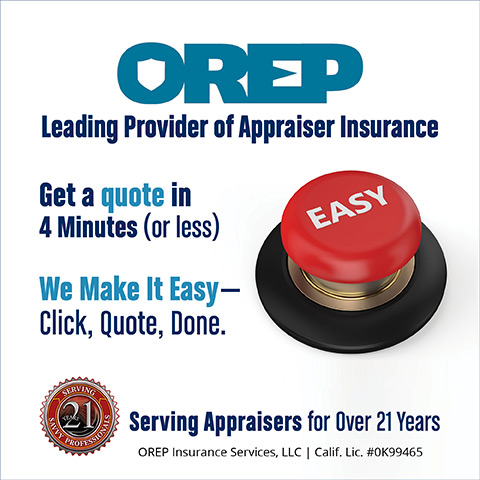 |
> The Appraiser Coach
> OREP E&O |
Grassroots Lobbying 101: How Appraisers Can Effect Change
by Isaac Peck, Publisher
The appraisal profession is relatively small and its political influence is modest—especially when compared with organizations like the National Association of Realtors (NAR) and the National Association of Home Builders (NAHB).
As a result, many appraisers feel powerless to effect change or exert influence within their regulatory system as well as in their local (and national) legislatures.
What could one appraiser, or even a handful of appraisers, do to change anything, anyway? Right?
The answer is likely more than you think.
Byron Miller, SRA, AI-RRS, ASA, RAA, MSSE and Chair of the Government Relations Sub-Committee for the North Star Chapter of the Appraisal Institute (NSAI-GRC), is one such appraiser. Alongside a handful of other passionate boots-on-the-ground real estate appraisers, Miller has succeeded in changing the regulatory environment for appraisers—in his home state of Minnesota.
In fact, nearly every single year, for the last seven years (2016 through 2022, except for the pandemic year of 2020), Miller and the NSAI-GRC team passed a law protecting appraisers and improving the laws governing real estate professionals.
Laws Passed
A summary of the NSAI-GRC team’s accomplishments include:
- 2016 Session: HF3901/SF3556—This legislation corrected several loopholes in the AMC law already on the books, amended the Customary and Reasonable fee provision of the AMC law; and clarified that no fees should be charged to the appraiser for a state board investigation if there was a finding of “no violation” against the appraiser. Miller got the idea for this bill after one of the members of his Chapter was investigated by the MN Department of Commerce (MN-DOC), found to be not in violation, and then was sent a bill for by the state for their investigation time!
- 2017 Session: HF593/SF366–This legislation created a six-year statute of limitations for civil actions against appraisers (except in cases involving fraud or intentional misrepresentation); modified appraiser background check requirements to bring them in line with Appraisal Qualifications Board (AQB) standards, and changed the regulatory process involving appraiser board complaints so that mere allegations of non-compliance with appraiser licensing laws would not be considered a formal complaint unless a disciplinary action results from it.
- 2018 Session: HF2829/SF2991–This legislation created the Minnesota Real Estate Appraisal Advisory Board (REAAB), a seven-person board appointed by the MN-DOC commissioner whose mission is to advise and provide best practices regarding real estate appraisers’ licensing, public disciplinary matters, continuing education, and industry-related trends.
- 2019 Session: HF2133/SF2016–This legislation provided precise definitions for Appraisal Review, simplified the temporary license process for out-of-state appraisers, and aligned the state licensing requirements with AQB criteria.
- 2021 Session: HF1768/SF785–This legislation allows appraisers to perform evaluation products that are exempt from USPAP, allows appraisers to take virtual CE equivalent to the classroom, and requires all appraisers in MN to take racial valuation bias education; one of the first states in the country to pass such legislation.
- 2022 Session: HF3784/SF3503–This legislation clarifies the state’s Customary and Reasonable Fee provision, an expansion of the 2021 evaluation legislation that allows appraisers to perform Minimum Damage Acquisition reports when the value is less than $25,000, and establishes Appraiser CE reciprocity with out of state synchronous coursework.
Whew—that’s a lot of legislation! So how exactly did a small group of appraisers manage to exert a steady, consistent influence on the legislative process in their state?
Working RE sat down with Byron Miller to answer that question.
Getting Started
When he first joined the NSAI-GRC as a committee member in 2012, Miller says the committee met with MN-DOC, (which is the state enforcement/regulation organization in Minnesota) and no progress was made. “We would meet with them and bring up initiatives we thought were important. Often, they responded favorably to our agenda. Six months later we’d circle back with them, and they’d act like it was the first time they’d heard it!,” Miller reports.
“We did that for almost two years before I had an epiphany. I realized that we were meeting with the enforcement unit, which is like going to the police to change the laws on search and seizure. We had to go to the folks making the laws, not the ones enforcing them…we had to go the legislature!,” says Miller.
To gain some insight on how “the big boys” do lobbying, Miller attended AI’s Leadership Development and Advisory Council (LDAC) in Washington, D.C. At LDAC, participants lobbied for AI national’s legislative agenda. “This experience was very helpful, in providing the basics of lobbying, as well as an understanding of how our legislative process works. It did not, however, provide me with the knowledge of drafting legislation or give me strategies for getting bills passed into law,” Miller says.
In 2015, Miller was appointed Chair of the NSAI-GRC Miller recalls that he accepted the position on the condition that he would get to pick his own team and that his team could set their own agenda. “The worst that could happen was nothing. I remember several people telling me we were going to fail because we couldn’t afford a lobbyist,” says Miller.
The definition of “lobby” is “To promote or secure the passage of legislation by influencing public officials.”
And so, faced with a number of important appraiser issues that needed to be addressed, Miller dove right in. “Lobbying—or getting legislation passed—is not rocket science. Very few things are. I started by studying up on it. You do need people skills. I have a minimum of those! You also need to be persistent, consistent, and organized. And those are things our Chapter learned to do well,” reports Miller.
Through meetings with the members of the NSAI Chapter, Miller and his team collected feedback on the issues that were most important to appraisers. At the time, Minnesota had already passed statutes that were out of alignment with Dodd-Frank and appraisers were also complaining about late payments from clients and non-competitive fees being offered. Appraisers were also being billed for the state’s investigators’ time even when the investigation found the appraiser “innocent!”
(story continues)
Lobbying 101
With a clear set of goals established based on feedback from his Chapter, Miller and his team began reaching out to state legislators and building relationships. “I first approached Democrat Jeff Hayden, the state senator for my district at the time, and pitched the idea of our bill to him. He agreed to sponsor the bill and he was a good mentor to me, along with Republican Representative Tim O’Driscoll. These mentors were invaluable to me, explained how things worked in the legislature, and gave me good advice on how to get things done,” Miller says.
Miller’s approach is instructive for any appraiser who wants to pass legislation: Start with the state legislators that represent your district. “I started with Hayden because I was one of his constituents. Legislators are usually much more inclined to meet with you if you are a constituent in the districts they represent, otherwise they might see you as just another lobbyist organization. We used that approach with every bill. We would find members of our Chapter who lived in particular districts and encourage them to provide an introduction for us to with key state legislators on the house and senate committees we were targeting,” Miller says.
That approach really resonated with legislators, Miller reports. “Whenever I would meet with a legislator, I would tell them I was a citizen lobbyist. I don’t get paid and I don’t even get my parking validated. This is my way of giving back to this profession that gave me so much. I’m trying to make a positive change for my profession and for my state. I had several legislators tell me that my approach made the difference. One told me ‘I get lots of people coming through my door, but you’re one of the few people that is truly altruistic and you’re not just in it for yourself,'” says Miller.
When he was younger, Miller said he swore he’d never get into politics. “My dad was a union president and I remember being exposed to many politicians of both parties. I guess it’s in your blood when you have the head of the state AFL-CIO over for dinner on a regular basis. The political process wasn’t really that foreign to me but I confess I actually went back and watched the ‘I’m just a bill, I’m only a bill’ episode from SchoolHouse Rock,” says Miller. (Visit https://www.youtube.com/watch?v=OgVKvqTItto to watch the clip.)
Some of the advice that Senator Hayden gave Miller was in order to pass laws, he needed bipartisan support. “Hayden gave me a list of his colleagues on the Democratic side and on the Republican side that work across the aisle. One person on that list was House Representative Tim O’Driscoll, a high-ranking Republican leader on the house side,” says Miller. “O’Driscoll and I hit it off right away. He provided invaluable insight on strategies to pass legislation in Minnesota.”
While Hayden was a Democrat, Republicans actually ended up being easier to work with, according to Miller, because many Democrats had a general view that anything “business” was bad or “the enemy.”
Nevertheless, having success in the legislature meant working with both parties. “We tailor our talking points and presentations based on who we are talking to. With Democrats, protecting the public trust really resonates with them. With Republicans, we emphasized that what we were proposing made good business sense. When we’d meet with our Chapter and encourage appraisers to contact their state legislators on a particular bill, we’d have two sets of talking points—one for the Dems and one for Republicans,” says Miller.
(story continues below)
(story continues)
Creating a Bill
Once the NSAI-GRC decided on the session’s agenda, it would typically ask the Appraisal Institute National for help in drafting the bill’s initial text. Scott Dibiasio, Manager of State and Industry Affairs at AI, played a crucial role in assisting Miller’s committee.
From there, it was up to the team and other boots-on-the-ground appraisers to meet with state legislators, build bipartisan coalitions in the state House and Senate, and get the bill introduced.
Introducing the Bill
The first step in getting a bill introduced is seeking out your initial sponsors. For each bill, Miller and his team would put together a cheat sheet of talking points for it. “We kept it short, one page or less. We also rehearsed our talking points, since we usually had less than 30 minutes with legislators (sometimes less than 10 minutes). In the meetings with legislators, we’d introduce ourselves, and outline our proposed bill and why it’s important. We would then give the one page sheet to the legislator and explain what we were trying to do. A typical sound bite goes like this: ‘We’re appraisers; we perform a very important consumer function by protecting the public trust, and so on.’ We’d even tailor it further to individual legislators based on our research. Find some commonality and try to build rapport,” says Miller.
Setting appointments with state legislators and representatives became a regular practice for Miller. “Many people don’t realize they can call their state senator’s or state representative’s office and get a meeting set. These folks are busy but they also serve their constituents. Sometimes I’d have to work hard to get a meeting and sometimes it would be cancelled at the last minute, but that’s the nature of the beast. The responses we’d get would run the gambit. Some people would politely express interest, others would bluntly tell you they have no interest in backing the bill, and others would say, ‘Hey, I only support X number of bills each session and I’m already tapped out this session.’ What mattered is that we stayed organized with our talking points and a clear one-pager that listed our bullet-point objectives and benefits. Why the bill we were proposing mattered to them and their constituents,” Miller says.
The key to success is getting the first few sponsors. Lots of legislators were wary of being the first “author” or sponsor of the bill, but once they saw others signed on, it’d be easier to get support. “In Minnesota, you can have up to five authors on the Senate side and 35 authors on the House side. We would always try to get a combination of authors from the Democrats and Republicans on both sides,” advises Miller.
Getting a Bill Passed
Once you have the bill drafted and introduced, it has to go through at least one, but sometimes several committees. “In Minnesota, bills dealing with state regulations will go through the commerce committee. If there’s a financial impact, it goes through the finance committee in both the state house and state senate. If there are other tangential issues with a bill, you could potentially have multiple hearings with various committees,” Miller reports.
Once the bill made it to the committee, Miller had to be ready to attend the committee hearing on very short notice. “My favorite was when I would get a phone call at 4:30 p.m. telling me, ‘Oh by the way, there’s a hearing on your bill tomorrow morning at the Senate Building at 7:30 a.m.’ When it’s your bill, you have to attend the committee hearings and speak in support of the bill. The legislators expect you to defend it and advocate for it. Speaking skills come in handy and I struggled with that at first. Some of the hearings are recorded as well,” Miller says.
On some bills, Miller had to attend multiple committees and testify multiple times. Occasionally other appraisers and the Department of Commerce opposed bills that Miller was working on, but keeping open communication and keeping a cool head kept things moving along.
Once a bill makes it through committee(s), on either house or the senate, it moves to the “floor.” If you’ve done your homework and built a bipartisan coalition, you have a very good chance at your bill becoming law.
Conclusion
Reflecting on his experiences over the last decade, Miller speaks with conviction and passion about how a little guy–an appraiser–can make a difference. “My experience shows that your individual voice can impact policy. You don’t need to have a big fancy lobbyist (although it doesn’t hurt). You can be impactful. It’s been a very empowering process, and I have been blessed with a good group of folks on the team to make it happen. A lot of people get disheartened by our political process, especially with the current quagmire, but very few people are actually willing to get involved and do the legwork to change things,” says Miller.
At his own Chapter, Miller says he often speaks with appraisers that are “too busy” to assist on the Government Relations Committee. “They tell me ‘I love what you’re doing, but I don’t have time for that.’ That’s frustrating for me because I’m busy too, and just a one-person appraisal shop. When I’m not doing appraisals, I’m not getting paid. I decided that this was important to give back. It’s a tradeoff. The way we set up our government relations team, there were four of us, so we could always balance the workload. Having a team that works effectively together enabled us to do that,” explains Miller.
If appraisers want to change things, Miller encourages them to get involved. “Appraisers can absolutely have more control over their profession if they stop waiting for other people to do the work.” Advocacy is essential for the survival of the appraisal profession. Most people have no clue how our legislative process works. Even though it’s not perfect, this is the best system we have in the world. If my story shows anything, it is that we can make a difference,” argues Miller.
If you’d like to contact Byron Miller, he can be reached at bmappraisals@isd.net.
About the Author
Isaac Peck is the Publisher of Working RE magazine and the President of OREP, a leading provider of E&O insurance for real estate professionals. OREP serves over 10,000 appraisers with comprehensive E&O coverage, competitive rates, and 14 hours of free CE for OREP Members (CE not approved in IL, MN, GA). Visit www.OREP.org to learn more. Reach Isaac at isaac@orep.org or (888) 347-5273. CA License #4116465.
OREP Insurance Services, LLC. Calif. License #0K99465




